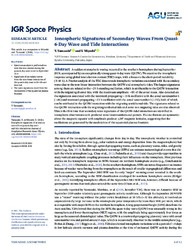Ionospheric Signatures of Secondary Waves From Quasi‐6‐Day Wave and Tide Interactions
Yamazaki, Y.; Miyoshi, Y., 2021: Ionospheric Signatures of Secondary Waves From Quasi‐6‐Day Wave and Tide Interactions. In: Journal of Geophysical Research: Space Physics, Band 126, 4, DOI: 10.23689/fidgeo-4278.
 |
Dokument öffnen: |
A sudden stratospheric waring occurred in the southern hemisphere during September 2019, accompanied by an exceptionally strong quasi‐6‐day wave (Q6DW). We examine the ionospheric response using global total electron content (TEC) maps, with a focus on the short‐period variability (5–48 h). A Fourier analysis of the TEC data reveals ionospheric variations associated with the secondary waves due to the non‐linear interaction between the Q6DW and atmospheric tides. The largest signatures among them are related to the ∼29‐h standing oscillation, which is attributable to the Q6DW interaction with the migrating diurnal tide, with the maximum amplitude ∼8% of the zonal mean. Also detected are the signatures associated with the westward‐propagating ∼13‐h oscillation with the zonal wavenumber 1 (∼4%) and westward‐propagating ∼11‐h oscillation with the zonal wavenumber 3 (∼3%), both of which can be attributed to the Q6DW interaction with the migrating semidiurnal tide. The signatures related to the Q6DW interaction with the migrating terdiurnal tide and some non‐migrating tides are also observed. This is the first time that secondary wave signatures of the Q6DW‐tidal interaction are identified in ionospheric observations with predicted zonal wavenumbers and periods. The oscillations are symmetric about the magnetic equator with amplitude peaks at ±20° magnetic latitudes, suggesting that the oscillations are generated by the modulation of the equatorial plasma fountain. Key Points:
Spectrum analysis is performed on total electron content during the quasi‐6‐day wave event in September 2019.
Signatures of secondary waves from the non‐linear interaction of the quasi‐6‐day wave with tides are detected.
The wave signatures result from the modulation of the equatorial plasma fountain.
Statistik:
ZugriffsstatistikSammlung:
Schlagworte:
atmospheric tidesnon‐linear interaction
quasi‐6‐day wave
secondary waves
sudden stratospheric warming
total electron content
This is an open access article under the terms of the Creative Commons Attribution License, which permits use, distribution and reproduction in any medium, provided the original work is properly cited.

